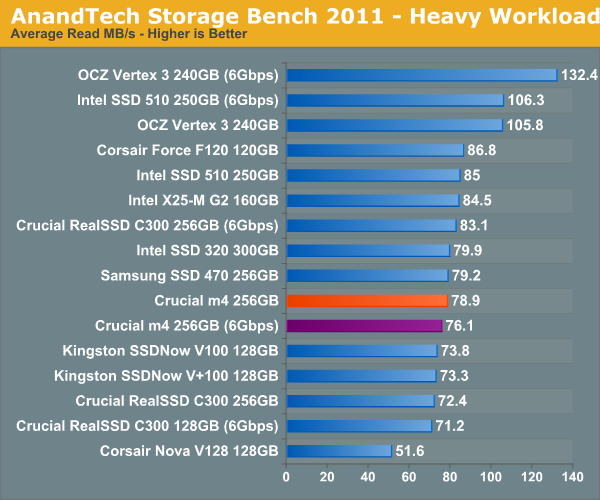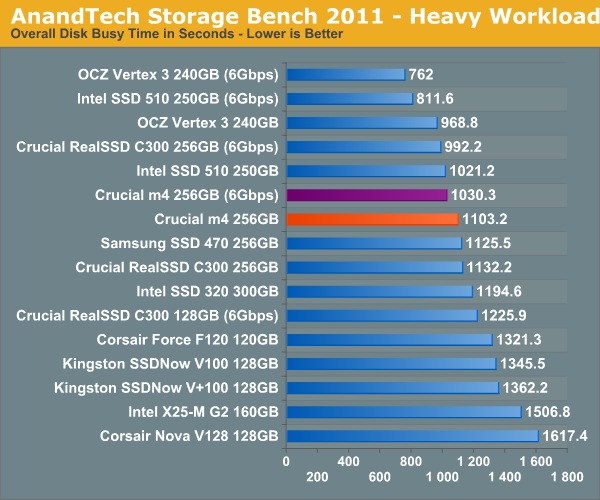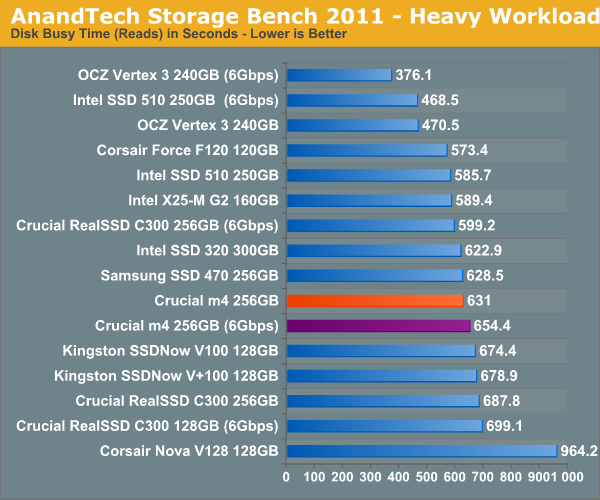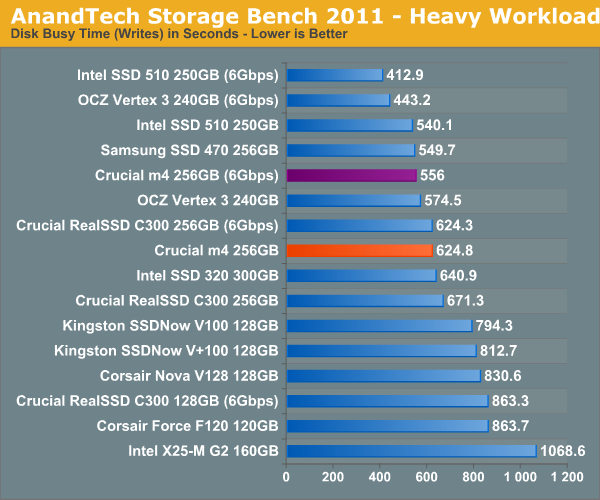The Crucial m4 (Micron C400) SSD Review
by Anand Lal Shimpi on March 31, 2011 3:16 AM ESTAnandTech Storage Bench 2011: Much Heavier
I didn't expect to have to debut this so soon, but I've been working on updated benchmarks for 2011. Last year we introduced our AnandTech Storage Bench, a suite of benchmarks that took traces of real OS/application usage and played them back in a repeatable manner. I assembled the traces myself out of frustration with the majority of what we have today in terms of SSD benchmarks.
Although the AnandTech Storage Bench tests did a good job of characterizing SSD performance, they weren't stressful enough. All of the tests performed less than 10GB of reads/writes and typically involved only 4GB of writes specifically. That's not even enough exceed the spare area on most SSDs. Most canned SSD benchmarks don't even come close to writing a single gigabyte of data, but that doesn't mean that simply writing 4GB is acceptable.
Originally I kept the benchmarks short enough that they wouldn't be a burden to run (~30 minutes) but long enough that they were representative of what a power user might do with their system.
Not too long ago I tweeted that I had created what I referred to as the Mother of All SSD Benchmarks (MOASB). Rather than only writing 4GB of data to the drive, this benchmark writes 106.32GB. It's the load you'd put on a drive after nearly two weeks of constant usage. And it takes a *long* time to run.
I'll be sharing the full details of the benchmark in some upcoming SSD articles but here are some details:
1) The MOASB, officially called AnandTech Storage Bench 2011—Heavy Workload, mainly focuses on the times when your I/O activity is the highest. There is a lot of downloading and application installing that happens during the course of this test. My thinking was that it's during application installs, file copies, downloading and multitasking with all of this that you can really notice performance differences between drives.
2) I tried to cover as many bases as possible with the software I incorporated into this test. There's a lot of photo editing in Photoshop, HTML editing in Dreamweaver, web browsing, game playing/level loading (Starcraft II & WoW are both a part of the test) as well as general use stuff (application installing, virus scanning). I included a large amount of email downloading, document creation and editing as well. To top it all off I even use Visual Studio 2008 to build Chromium during the test.
Update: As promised, some more details about our Heavy Workload for 2011.
The test has 2,168,893 read operations and 1,783,447 write operations. The IO breakdown is as follows:
| AnandTech Storage Bench 2011—Heavy Workload IO Breakdown | ||||
| IO Size | % of Total | |||
| 4KB | 28% | |||
| 16KB | 10% | |||
| 32KB | 10% | |||
| 64KB | 4% | |||
Only 42% of all operations are sequential, the rest range from pseudo to fully random (with most falling in the pseudo-random category). Average queue depth is 4.625 IOs, with 59% of operations taking place in an IO queue of 1.
Many of you have asked for a better way to really characterize performance. Simply looking at IOPS doesn't really say much. As a result I'm going to be presenting Storage Bench 2011 data in a slightly different way. We'll have performance represented as Average MB/s, with higher numbers being better. At the same time I'll be reporting how long the SSD was busy while running this test. These disk busy graphs will show you exactly how much time was shaved off by using a faster drive vs. a slower one during the course of this test. Finally, I will also break out performance into reads, writes and combined. The reason I do this is to help balance out the fact that this test is unusually write intensive, which can often hide the benefits of a drive with good read performance.
There's also a new light workload for 2011. This is a far more reasonable, typical every day use case benchmark. Lots of web browsing, photo editing (but with a greater focus on photo consumption), video playback as well as some application installs and gaming. This test isn't nearly as write intensive as the MOASB but it's still multiple times more write intensive than what we were running last year.
As always I don't believe that these two benchmarks alone are enough to characterize the performance of a drive, but hopefully along with the rest of our tests they will help provide a better idea.
The testbed for Storage Bench 2011 has changed as well. We're now using a Sandy Bridge platform with full 6Gbps support for these tests. All of the older tests are still run on our X58 platform.
AnandTech Storage Bench 2011—Heavy Workload
We'll start out by looking at average data rate throughout our new heavy workload test:

While we saw a pretty significant difference between 3Gbps and 6Gbps interfaces with the Intel 510 and Vertex 3, but the same can't be said about Crucial's m4. There's only a 7% performance improvement seen by using a 6Gbps connector on our Sandy Bridge system. Even more interesting is that performance actually drops a bit compared to the C300. We saw this in some of our synthetic Iometer tests and it's definitely reflected here.
The breakdown of reads vs. writes tells us more of what's going on:

The drop in sequential and random read performance we noticed seems to be at fault for the m4's lower-than-C300 performance. Looking at write speeds we actually see an improvement over the C300:

The next three charts just represent the same data, but in a different manner. Instead of looking at average data rate, we're looking at how long the disk was busy for during this entire test. Note that disk busy time excludes any and all idles, this is just how long the SSD was busy doing something:













103 Comments
View All Comments
casteve - Thursday, March 31, 2011 - link
+1The biggest problem is SSD mfgrs push the high capacity drives out for review to show their products in the best possible light rather than the (more mainstream) boot drive-sized SSDs.
Anand, here's hoping you will fill these charts in with more 64GB and 128GB reviews. I don't care about 256GB performance.
Anand Lal Shimpi - Thursday, March 31, 2011 - link
I always request the smaller capacity drives. Launch reviews tend to feature the big ones but I try my best to fill in the smaller ones as time goes on.ckevin1 - Friday, April 1, 2011 - link
Speaking of drive size disparities -- why is the Corsair F120 on these charts, instead of the F240?We don't have a comparison to any of the top performing SF1200 drives.
sticks435 - Thursday, March 31, 2011 - link
++1. Especially when building something like a gaming PC, where because of the stream of console ports, you can build a screaming system for $1000 or so. Not spending half my budget on a SSD.JNo - Friday, April 1, 2011 - link
+1 for smaller drive figuresiamezza - Friday, April 1, 2011 - link
+1 for price/GB, reliabilitycknobman - Thursday, March 31, 2011 - link
Id say for anyone still rocking a SATA II interface (like me with my notebook) Intel 320 series is the clear winner now.I was leaning towards an OCZ Vertex 2 Sandforce 1200 series drive but I read too many horror stories of OCZ's reliability.
Intels new 320 series looks to be pretty solid and fast.
Martimus - Thursday, March 31, 2011 - link
Many people on our forums are having an issue with stuttering on the C300 drive (seen here: http://forums.anandtech.com/showthread.php?t=21398...It is accompanied with the error:"The device, \Device\Ide\iaStor0, did not respond within the timeout period."
Does the C400 have this same issue? All the people who have reported the problem are using P67 chipset motherboards.
adamantinepiggy - Thursday, March 31, 2011 - link
I believe I ran into stuttering issues with the p67 chipset, i2600k Win7-64 and C400 with release firmware using the last two Intel SATA port drivers (9.xx and 10.xx). It manifested itself with odd PCMark Vantage HHD suite results. Basically, running the tests would incur a "0" result in one or more tests like the gaming part. In about 10 runs of the Vantage HDD suite test, over 2/3 would fail because of this. When it did complete, it would only return about 45,000 marks. Perplexed on this behavior, I changed driver for the SATA port to the stock MSAHCI (via upgrade driver in device manager) and the problem went away to where I was getting consistant 57000ish marks on this test.To see if I could replicate this issue, I again changed the SATA port driver back to the same latest Intel 10.xx SATA port driver (again via device manager) and the problem never returned. With the now-working Intel driver/c400 interface, PCMark Vantage HDD Suite now gives us 64000+ on an empty 256GB C400. This was done on an original ASUS and MSI bugged-P67 chipset (SATA2 3G/s port fail bug, however I only use the Intel SATA3 6G/s ports for testing so have not returned them).
No I don't know why it occurs or if it affects all of the P67 MB's when used with the C400's. While it interests me in figuring out why, I only have so many work-hours a day to do things and my misson in that particular case was was to make a stable P67 platform for benchmark testing (which I accomplished), not determine root causes for things I could get around (weird bugs). Unfortunately (or maybe fortunately :-), I am not an engineer, I am the merely the resident tech hardware enthusiast who actually makes the stuff work for the real engineers.. This MSI P67-GD65 motherboard continues to be the standard benchmark machine for Micron R&D test results until I can get the time to order a post-bug fix replacement.
A interesting FYI: is that this MSI P67-GD65 motherboard consistently outperforms the ASUS P8P67 by about 2-4% in disk i/o at "stock" CPU speeds (we don't overclock bench machines, but from a "I-like-to-play-with-stuff" perspective, the ASUS overclocks much better/easier!).
jimhsu - Thursday, March 31, 2011 - link
If you are using the C300 with Intel RST 9.x or 10.x, there is a specific fix:http://forums.crucial.com/t5/Solid-State-Drives-SS...
The problem has been solved for all the responders on the thread including me.